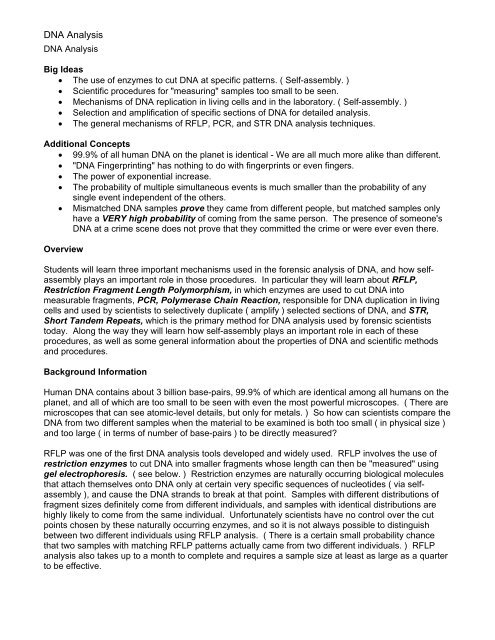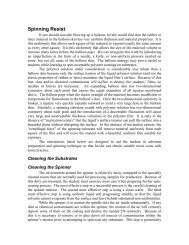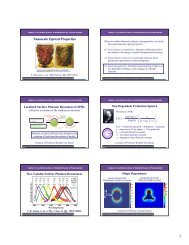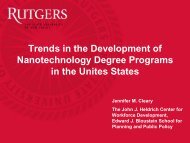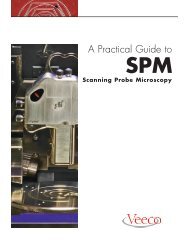DNA Fingerprinting Lesson Plan
DNA Fingerprinting Lesson Plan
DNA Fingerprinting Lesson Plan
You also want an ePaper? Increase the reach of your titles
YUMPU automatically turns print PDFs into web optimized ePapers that Google loves.
<strong>DNA</strong> Analysis<br />
<strong>DNA</strong> Analysis<br />
Big Ideas<br />
• The use of enzymes to cut <strong>DNA</strong> at specific patterns. ( Self-assembly. )<br />
• Scientific procedures for "measuring" samples too small to be seen.<br />
• Mechanisms of <strong>DNA</strong> replication in living cells and in the laboratory. ( Self-assembly. )<br />
• Selection and amplification of specific sections of <strong>DNA</strong> for detailed analysis.<br />
• The general mechanisms of RFLP, PCR, and STR <strong>DNA</strong> analysis techniques.<br />
Additional Concepts<br />
• 99.9% of all human <strong>DNA</strong> on the planet is identical - We are all much more alike than different.<br />
• "<strong>DNA</strong> <strong>Fingerprinting</strong>" has nothing to do with fingerprints or even fingers.<br />
• The power of exponential increase.<br />
• The probability of multiple simultaneous events is much smaller than the probability of any<br />
single event independent of the others.<br />
• Mismatched <strong>DNA</strong> samples prove they came from different people, but matched samples only<br />
have a VERY high probability of coming from the same person. The presence of someone's<br />
<strong>DNA</strong> at a crime scene does not prove that they committed the crime or were ever even there.<br />
Overview<br />
Students will learn three important mechanisms used in the forensic analysis of <strong>DNA</strong>, and how selfassembly<br />
plays an important role in those procedures. In particular they will learn about RFLP,<br />
Restriction Fragment Length Polymorphism, in which enzymes are used to cut <strong>DNA</strong> into<br />
measurable fragments, PCR, Polymerase Chain Reaction, responsible for <strong>DNA</strong> duplication in living<br />
cells and used by scientists to selectively duplicate ( amplify ) selected sections of <strong>DNA</strong>, and STR,<br />
Short Tandem Repeats, which is the primary method for <strong>DNA</strong> analysis used by forensic scientists<br />
today. Along the way they will learn how self-assembly plays an important role in each of these<br />
procedures, as well as some general information about the properties of <strong>DNA</strong> and scientific methods<br />
and procedures.<br />
Background Information<br />
Human <strong>DNA</strong> contains about 3 billion base-pairs, 99.9% of which are identical among all humans on the<br />
planet, and all of which are too small to be seen with even the most powerful microscopes. ( There are<br />
microscopes that can see atomic-level details, but only for metals. ) So how can scientists compare the<br />
<strong>DNA</strong> from two different samples when the material to be examined is both too small ( in physical size )<br />
and too large ( in terms of number of base-pairs ) to be directly measured?<br />
RFLP was one of the first <strong>DNA</strong> analysis tools developed and widely used. RFLP involves the use of<br />
restriction enzymes to cut <strong>DNA</strong> into smaller fragments whose length can then be "measured" using<br />
gel electrophoresis. ( see below. ) Restriction enzymes are naturally occurring biological molecules<br />
that attach themselves onto <strong>DNA</strong> only at certain very specific sequences of nucleotides ( via selfassembly<br />
), and cause the <strong>DNA</strong> strands to break at that point. Samples with different distributions of<br />
fragment sizes definitely come from different individuals, and samples with identical distributions are<br />
highly likely to come from the same individual. Unfortunately scientists have no control over the cut<br />
points chosen by these naturally occurring enzymes, and so it is not always possible to distinguish<br />
between two different individuals using RFLP analysis. ( There is a certain small probability chance<br />
that two samples with matching RFLP patterns actually came from two different individuals. ) RFLP<br />
analysis also takes up to a month to complete and requires a sample size at least as large as a quarter<br />
to be effective.
<strong>DNA</strong> Analysis<br />
Gel electrophoresis is a technique that scientists use to "measure" the size of <strong>DNA</strong> fragments. <strong>DNA</strong><br />
samples are first tagged with a dye, and then injected near one edge of an agarose gel. An electric<br />
current is then applied, which pulls the <strong>DNA</strong> material through the gel. Smaller fragments travel farther<br />
through the gel in a given time, which can then be detected thanks to the dye. A reference sample of<br />
known material is always included, to set a scale for the results.<br />
Figure 1 - Typical electrophoresis gel<br />
Whenever a cell replicates itself, all of the contents of the cell must be duplicated, including the <strong>DNA</strong><br />
within the cell. The mechanism by which this happens starts with unwinding and then separating the<br />
two strands of <strong>DNA</strong> from their initial double helix configuration. Each single strand then grows a<br />
complementary mate through a polymerization reaction controlled by the biological chemical<br />
polymerase. This polymerization reaction is termed the polymerase chain reaction, PCR. The<br />
original strand serves as a template to ensure that only a specific matching strand of <strong>DNA</strong> gets created,<br />
in an example of self-assembly.<br />
Within the laboratory scientists can use the polymerase chain reaction in a slightly different form in<br />
order to duplicate ( amplify ) a specifically chosen section of <strong>DNA</strong> for further analysis. First the <strong>DNA</strong> is<br />
heated to completely unwind and separate the two strands. Then primers are added onto the <strong>DNA</strong><br />
strands in specific locations ( using self-assembly ) as starting points for the polymerization. Finally the<br />
polymerase chain reaction is used to grow duplicate strands on each of the two original single strands.<br />
This procedure is then repeated for 20 to 30 cycles, yielding millions to billions of copies through the<br />
power of exponential increase. Careful selection of the original primers limits the duplication process to<br />
only a short specific section of the original <strong>DNA</strong>. PCR can be applied to samples as small as a single<br />
molecule, and even to degraded <strong>DNA</strong> that may have been broken down by time or harsh environments.<br />
Short Tandem Repeats, STRs, are short sections of <strong>DNA</strong> which repeat themselves a certain number<br />
of times. Where the repeat count differs among different individuals, it changes the length of the<br />
encompassing <strong>DNA</strong> fragment, which can be isolated with PCR and analyzed with gel electrophoresis.<br />
STR sections are frequently found within the 98% or so of "junk <strong>DNA</strong>" or "non-coding <strong>DNA</strong>" that does<br />
not contain the codes for any known genetic traits. The probability of two random individuals having<br />
identical STR counts at one particular <strong>DNA</strong> location ( loci ) is relatively large, but the chances of this<br />
happening at thirteen different loci ( the number used in U.S. forensics ) are so vanishingly small as to<br />
be nearly impossible. ( Identical twins, triplets, etc. have identical <strong>DNA</strong>, and the probability of<br />
laboratory error is higher than the statistical probability of random <strong>DNA</strong> matching. )
<strong>DNA</strong> Analysis<br />
Major Learning Goals<br />
1. The student can explain the general mechanism of three important procedures in forensic <strong>DNA</strong><br />
analysis, and explain how self-assembly play a part in each one.<br />
A. RFLP, cutting <strong>DNA</strong> into fragments with restriction enzymes.<br />
B. PCR, selectively amplifying specific sections of <strong>DNA</strong> strands.<br />
C. STR, analyzing fragment length differences due to variable numbers of short tandem<br />
repeats.<br />
2. The student can illustrate how <strong>DNA</strong> replication occurs in both a living cell and in the laboratory,<br />
and can indicate which important steps involve self-assembly.<br />
3. The student can explain how scientists "measure" the size of <strong>DNA</strong> fragments, which are both<br />
too small ( in physical size ) and too large ( in numbers of base pairs ) to examine visually.<br />
Secondary Learning Goals<br />
1. The student understands that 99.9% of human <strong>DNA</strong> on the planet is identical.<br />
2. The student understands the power of exponential growth ( amplification. )<br />
3. The student learns that the chances of multiple events occurring simultaneously are much<br />
smaller than the chances of each event happening independently.<br />
4. The student understands that mismatching <strong>DNA</strong> results prove the samples came from two<br />
different individuals, but that matching results only show an infinitesimally small chance that<br />
they could have come from two different individuals, and that the presence of a suspect's <strong>DNA</strong><br />
at a crime scene does not prove that they committed the crime, or were ever even there.<br />
Activities<br />
Students will be presented with the information described above in a prepared PowerPoint<br />
presentation. In addition, the students will participate in a number of interactive activities centered<br />
about the motivating example of solving a crime mystery:<br />
1. Visual examination of five strings of beads representing five samples of <strong>DNA</strong>. Students should<br />
conclude that this would not be a practical method for analyzing <strong>DNA</strong>.<br />
2. "Cutting" the <strong>DNA</strong> models into fragment lengths, using clothespins representing restriction<br />
enzymes. At this point a visual examination should rule out one of the four suspects but be<br />
unable to distinguish the other four <strong>DNA</strong> samples.<br />
3. Simulating PCR amplification by duplicating a section of the <strong>DNA</strong> bead models into individual<br />
bracelets. First one student makes a duplicate, then two students, then 4, 8, 16, etc to illustrate<br />
the power of exponential growth. Each student gets to take their copy home as a souvenir.<br />
4. Simulating STR analysis by very carefully measuring the lengths of <strong>DNA</strong> sections marked by<br />
clothespins representing primers, and plotting their results on graph paper. Through this<br />
analysis students can rule out all suspects except one, and solve the motivating crime.<br />
References<br />
1. http://en.wikipedia.org/wiki/Genetic_fingerprinting<br />
2. http://en.wikipedia.org/wiki/Dna<br />
3. http://en.wikipedia.org/wiki/Chromosome<br />
4. http://en.wikipedia.org/wiki/Gene<br />
5. http://workbench.concord.org/database/activities/260.html


